Enemies who are captured with weapons are shot
In December 1968 the Firebirds gun platoon was assigned a separate 90-day mission away from normal 71st AHC operations to support the Command-and-Control North (CCN) ‘sneaky Pete’ missions into Laos. The staging base and mission launch point was Quang Tri located a few miles south of the DMZ line between North and South Vietnam. Sneaky Pete missions, a great adventure!
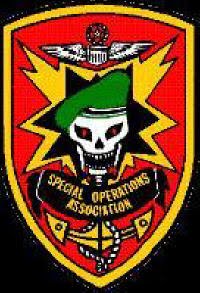
The route into Laos from Quang Tri follows highway Route 9 westward. The route to Quang Tri from Danang follows Highway 1 and is now known as the QL1A north. 55 miles north of Danang is Hue that marks the half-way point. Flying past Phu Bai airfield are the wrecked remnants of Air Vietnam. After Hue is Quang Tri.
Flying north from Danang, the QL1A is the most expeditious and probably safest route to Quang Tri, by both motor and air. Two other options – to the east is a circuitous route around Monkey Mountain and over water. To the west is high mountain terrain. Neither option is favorable. The QL1A ascends through a 3,500 ft. mountain road pass over what was affectionately named Monkey Mountain. The high pass was often obscured with low mist and rain during the monsoon season that sometimes required a delay at the Green Beret ‘C’ team headquarters in Danang. Delays were always expected and not unusual. Overnights at the C team was always enjoyable with cheeseburgers and French fries. The Green Berets rear echelon staffers knew how to live.
Once clear of Monkey Mountain pass on Highway 1 our flight continued northbound past Phu Bai and then over the once classic city of Hue. The Perfume River, the walled Citadel, and the former 1968 Tet Offensive battle zones were all visible on our fly-by. Quang Tri would be ‘home’ off & on for the next three months with ten-day duty rotations back to Chu Lai and Baldy. The MAG 16 (Marine Air Group) provided billeting, mess hall facilities, and life support during our stay. The mattress in the MAG 16 billet was the softest ever slept on during my Vietnam tour. Score one comfort attaboy for the Marines!
Due to the classified nature of the mission, the twice daily briefings were held in a large, closed tent near our helicopters. The standby area was kept away from the airfield and prying eyes. Our mission was inserting mercenaries into Laos to hopefully observe/find American POWs, scout the Ho Chi Minh trail, locate logistical support sites, and otherwise create chaos for the NVA. Prior to each flight, every crewman surrendered all military and other U.S. identification to the operations section chief.
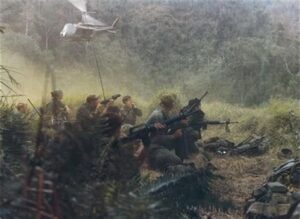
Although the Green Berets staffed these missions at Quang Tri, the use of mercenaries left no doubt the American CIA was the overseer. Code named Studies and Observation Group (SOG) but, it really was the Special Operations Group known as Command-and-Control North (CCN). Later when the CCN missions were terminated, all the existing records of personnel, flights, etc. were destroyed by the Green Berets command staff. The Special Operations Association (SOA) verified the destruction 50 years after the close of hostilities in South Vietnam. What was once great spy telling story stuff became a mere memory – but still great bar war stories!
Diplomatically neutral, Laos was unfriendly toward U.S. combatants on their soil. So much so that any American combatants captured by Laotian forces would be treated as spies with the possibility of execution. Or so we were told. The actual mercenaries insertion was flown by the 219th King Bees squadron of the South Vietnam Air Force. The King Bees operated older H-34 piston powered helicopters painted in ‘no-see-me’ jungle camouflage. The Green Berets requested our helicopters painted black – request denied.
Load and launch, then fly/follow over Route 9 toward LZ Vandegrift for final refuel before jumping the border. Marine grunts were always camped out alongside the runway at Vandegrift. The grunts lay on the ground with their ruck packs as pillows waiting for the go code to jump as a quick reaction force. Little did I know at the time, a Marine PFC childhood neighbor was killed a few months earlier in this same area. Route 9 parallels the Thach Han River valley into the mountains west of Quang Tri.
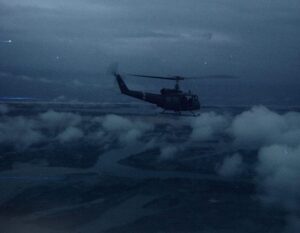
Because of the winter monsoon season, the weather was always cloudy and overcast that constantly necessitated flying below the steep mountain hillsides through the valley. Never in the three-month mission was there ever a sunny day – just perpetual gloom. The bad news in the narrow river valley was the reported enemy weapons emplacements all along the route. The briefing maps had so many red spots marking gun positions, it looked like the map had the measles. We flew so low in the valley, the bad guys on the mountain sides could literally shoot downward onto our flight formations. But our weapons could not shoot upwards.
15 helicopters were required for these insertions – six gunships, three rescue helicopters and the six King Bee camo birds containing the mercenaries. Mission ‘control’ high overhead was a USAF C-130 Hercules designated call sign – Crown. With ultra-sophisticated communication and navigation gear, Crown monitored and directed the flights into and out of Laos. There were no ‘Welcome to Laos’ road signs and the demarcation boundary was unidentifiable in the high mountains. Crossing the border was an eerie event.
The actual mission involved the insertion of the special operations mercs onto Laotian soil. The mercenaries were all an international amalgam – no Americans among them. These guys sported all manner of weaponry including one guy with a very large chrome bladed Bowie knife. ‘You boys stay away from them’ was the admonishment from the Green Berets operations sergeant. You got it!
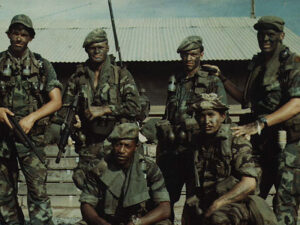
Average mission length was ten days on the ground unless the teams ran into trouble and needed earlier extraction. One such team did require early removal – we extracted them as they were being chased through the high jungle by the bad guys. Not so much an extraction but a successful rescue of the entire team. Accolades all around and valorous awards announced but never received as all records of the flights and involvement destroyed. Nixon said we were never there.
The good news was returning to the MAG 16 club for dinner and drinks. But before that – if we still had artillery on board after recrossing into Vietnam, we would make a 180-degree in-flight turn and salvo all the remaining rockets into Laos. Special delivery via air mail – what fun is that! Back in the club the Marine pilots were crazy guys notably Tiny who was cousin to the jolly green giant and Fritz who was bald, had a handlebar mustache, and a monocle eye piece like the Kaiser. Crazier than the Firebirds, and that is saying something.
But the King Bee pilots were another story – all clad in tailored black flight suits with white silk neck scarves. Black baseball caps and aviator style sunglasses. Appropriate attire for arrogant aviators flying or bar hopping in Sigh-Gone. The crews walked around together in pairs – one pilot, one co-pilot. The significance was one pilot was designated as the take-off and landing pilot; the other was the ‘straight & level’ flying pilot. Maybe VNAF pilot union work rules?
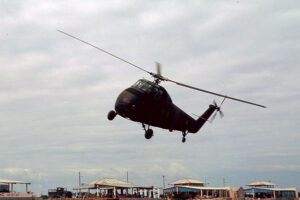
One King Bee curiosity was their reluctance to continue flying if they were shot at. Several times on the way to Laos when the group began receiving ground fire, the King Bees would turn back toward Quang Tri and announce over the radio, ‘King Bee go home now’. No King Bee, NO! – don’t go home, ‘King Bee go home now’. And that would be the end of that mission. Like King Bee, I often wished that I could ‘go home now’.
(c) Copyright – 2023 Vic Bandini